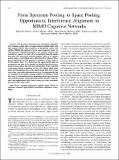From Spectrum Pooling to Space Pooling: Opportunistic Interference Alignment in MIMO Cognitive Networks
Author(s)
Perlaza, Samir M.; Fawaz, Nadia; Lasaulce, Samson; Debbah, Merouane
DownloadPerlaza-2010-From Spectrum Poolin.pdf (1.099Mb)
PUBLISHER_POLICY
Publisher Policy
Article is made available in accordance with the publisher's policy and may be subject to US copyright law. Please refer to the publisher's site for terms of use.
Terms of use
Metadata
Show full item recordAbstract
We describe a noncooperative interference alignment (IA) technique which allows an opportunistic multiple input multiple output (MIMO) link (secondary) to harmlessly coexist with another MIMO link (primary) in the same frequency band. Assuming perfect channel knowledge at the primary receiver and transmitter, capacity is achieved by transmiting along the spatial directions (SD) associated with the singular values of its channel matrix using a water-filling power allocation (PA) scheme. Often, power limitations lead the primary transmitter to leave some of its SD unused. Here, it is shown that the opportunistic link can transmit its own data if it is possible to align the interference produced on the primary link with such unused SDs. We provide both a processing scheme to perform IA and a PA scheme which maximizes the transmission rate of the opportunistic link. The asymptotes of the achievable transmission rates of the opportunistic link are obtained in the regime of large numbers of antennas. Using this result, it is demonstrated that depending on the signal-to-noise ratio and the number of transmit and receive antennas of the primary and opportunistic links, both systems can achieve transmission rates of the same order.
Date issued
2010-07Department
Massachusetts Institute of Technology. Research Laboratory of ElectronicsJournal
IEEE Transactions on Signal Processing
Publisher
Institute of Electrical and Electronics Engineers
Citation
Perlaza, Samir M. et al. “From Spectrum Pooling to Space Pooling: Opportunistic Interference Alignment in MIMO Cognitive Networks.” IEEE Transactions on Signal Processing 58.7 (2010): 3728–3741. Web.© 2010 IEEE.
Version: Final published version
Other identifiers
INSPEC Accession Number: 11432865
ISSN
1053-587X
1941-0476